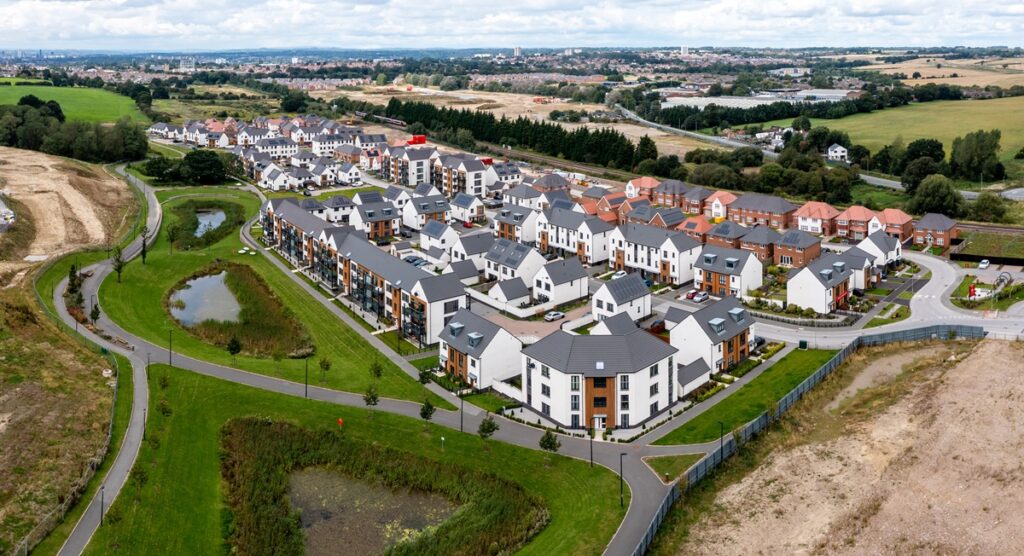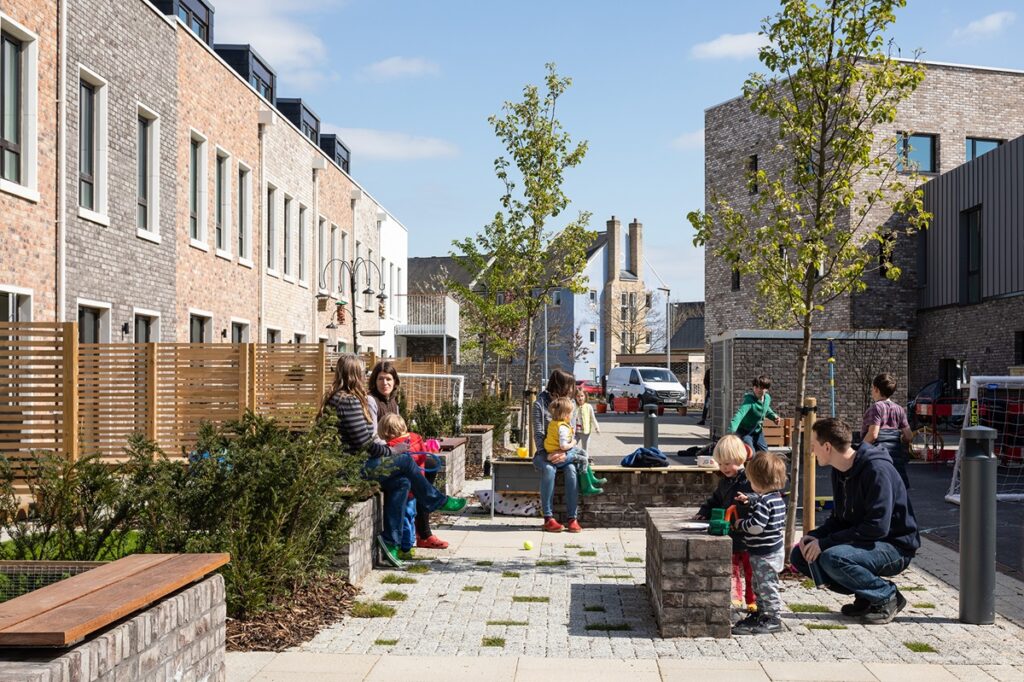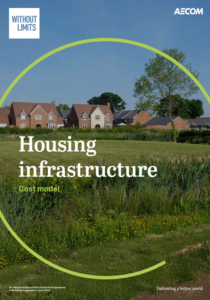The infrastructure challenge behind England’s housing targets
Supporting infrastructure is critical to housing delivery — but its demands and costs are often overlooked. As the government aims to build 1.5 million new homes in England, that ambition is at risk without the roads, utilities and public services needed to make development viable, as Paul Wilcock, Nick Jones, Patrick Clarke and Channa Karunaratne report.
The Labour government has promised 1.5 million new homes in England by 2029 — a target that was reinforced in the latest Spending Review, which announced £39 billion in public funding over the next decade to accelerate the delivery of social and affordable housing.
New homes and towns, of course, do not exist in isolation: they require many other buildings, spaces, and places to support them. The cost and demands of delivering these is vast and at present, highly underreported.
Coordinating, funding and delivering this supporting infrastructure will be central to the success or failure of the government’s plans.
What supporting infrastructure is needed?
Major new physical infrastructure is required to support new community developments, including roads, utilities, drainage, and landscaping. In many cases existing offsite roads must be widened, new junctions created, and roundabouts made bigger to accommodate additional traffic. Power, data and heat networks must also be created.
There is social infrastructure to consider as well. There must be adequate public transport connectivity, schools, healthcare, leisure and sports, emergency services and community centres capacity. District centres must also be created — the high streets where communities can meet, shop and access services such as a local post office, barbers, food and retail and a doctor’s surgery.
‘Green’ and ‘blue’ infrastructure must also be delivered. Green infrastructure includes parks, allotments, playing fields, woodland, and private gardens, with the aim of creating healthy, biodiverse places to live. Blue infrastructure includes the flood plains, water treatment facilities, rivers and canals that serve an area. Arrangements for the long-term stewardship of these assets created also must be agreed.

How is this supporting infrastructure funded?
Supporting infrastructure for housing is usually funded by Section 106 (S106) agreements. As a legal agreement between local planning authorities and those with an interest in the land to be developed, these contracts are linked to planning permissions and can also be known as planning obligations.
S106 agreements provide an effective mechanism for securing infrastructure delivery. However, they can often be a source of contention and debate between developers and the public sector — and create long-term delays to projects.
Access to upfront finance and the cost of that finance is often a key barrier to prompt development. Supporting infrastructure must be built and funded upfront, and therefore developers must invest significant amounts in supporting infrastructure before they can start selling homes. It is not just the capital cost, but the cost of this finance that prevents schemes progressing. Most commercial developers must borrow this money, at current interest rates of around seven to nine percent.
Serviced land is the goal – but the delivery model sets the pace
Many larger housebuilding schemes run under a master developer model; whereby major landowners provide serviced parcels of land for development by others.
As such they enable the development by leasing or selling land they own. They lead the direction of the project and achieve planning consent for it. Another focus is on the project’s long-term legacy, and quality stewardship of the land and the resulting housing development; but when it comes to delivering homes, house builders are brought in to partner with them.
The government’s housing agency Homes England is another major provider of new housing.
In a recent significant project, Homes England collaborated with AECOM as lead consultant to achieve planning consent for a major scheme in the South of England. Homes England is now delivering the strategic infrastructure to enable them to provide serviced land and enter into an agreement for lease for disposal of plots or parcels of land to house builders.
The question is what it costs to deliver and provide serviced land.
Answering this is now a major concern, as the government seeks to unlock planning issues and rapidly roll out new housing developments.

“For developers, housebuilding projects represent taking on high levels of risk. However, both central government – and local authorities with consultants advising and supporting them – are essential to de-risking projects to develop in a way which will enable quality homes and a legacy to be proud of.”
The long-term factors that shape successful housing delivery
The factors to consider when masterplanning a new housing development are sprawling, but key considerations include:
1/ Site location is critical to the success of a new major housing development. It often makes sense to locate a new town or large development adjacent to existing urban areas. This creates opportunities to share infrastructure between existing and new communities, and to invest in the improvement of existing facilities rather than providing wholly new facilities. However, such land tends to have a higher established land value, which can reduce the profit or uplift needed to fund infrastructure.
2/ The embodied carbon cost of delivering new homes is significant. To be truly sustainable, and to mitigate its embodied carbon, new housing should have a life of 200-300 years.
3/ The government’s drive to add more homes, and thus more energy demand, to England’s housing stock is set against a backdrop of a network that is struggling to meet existing power needs. There is an estimated £80 billion worth of large-scale heat network infrastructure planned for the U.K. over the next decade: in a new housing development, a heat network is likely the most flexible and efficient way of moving and sharing energy. Mandating heat-generating buildings such as waste treatment facilities or data centres to connect to and provide their waste heat to domestic heat networks could have a hugely positive impact on costs, security of heat supply and national decarbonisation.
The true cost of supporting infrastructure is, at present, an unanswered question
Good homes drive positive economic and social change for everyone. From Cadbury’s Bourneville development to Ebenezer Howard’s Garden Cities movement, the U.K. has a long history of housing innovation, creating new villages, towns and cities that improve their residents’ lives and provide a blueprint for others to follow.
There is also clear evidence that we can deliver affordable housing at scale in tough economic conditions.
For developers, housebuilding projects represent taking on high levels of risk. However, both central government — and local authorities with consultants advising and supporting them — are essential to de-risking projects to develop in a way which will enable quality homes and a legacy to be proud of.
Furthermore, the homes and towns that are built must create a positive legacy. If we do not build quality homes, designed to last, we will compound the housing crisis by leaving the future generations to grapple with poor quality, disconnected homes and communities.
This requires a proactive approach from central government and local authorities: supporting the private sector to identify projects, shape them carefully, and act as pragmatic and practical visionaries to enable delivery to happen.
Cost model: housing infrastructure
 The cost model is based on a Master Developer carrying out site preparation, infrastructure and S106/community infrastructure works to provide serviced plots for disposal to housebuilders.
The cost model is based on a Master Developer carrying out site preparation, infrastructure and S106/community infrastructure works to provide serviced plots for disposal to housebuilders.
This is for a new settlement of approximately 4,000 residential units in a regional location outside the South East.
This scheme will be developed on a 225 hectare greenfield site with good access and relatively level topography close to existing settlements with established infrastructure.
The costs exclude all on plot costs VAT.
To access the full article and cost model please click here.
Click here to read the full article published in Building.






